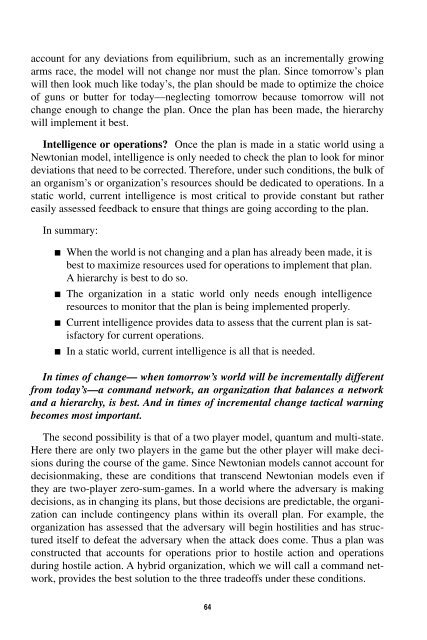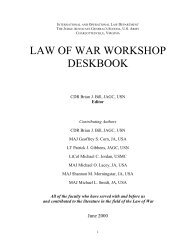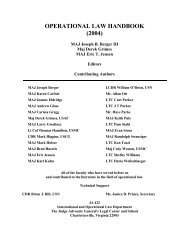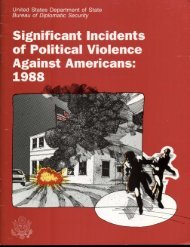Warning Analysis for the Information Age - Higgins Counterterrorism ...
Warning Analysis for the Information Age - Higgins Counterterrorism ...
Warning Analysis for the Information Age - Higgins Counterterrorism ...
You also want an ePaper? Increase the reach of your titles
YUMPU automatically turns print PDFs into web optimized ePapers that Google loves.
account <strong>for</strong> any deviations from equilibrium, such as an incrementally growingarms race, <strong>the</strong> model will not change nor must <strong>the</strong> plan. Since tomorrow’s planwill <strong>the</strong>n look much like today’s, <strong>the</strong> plan should be made to optimize <strong>the</strong> choiceof guns or butter <strong>for</strong> today—neglecting tomorrow because tomorrow will notchange enough to change <strong>the</strong> plan. Once <strong>the</strong> plan has been made, <strong>the</strong> hierarchywill implement it best.Intelligence or operations? Once <strong>the</strong> plan is made in a static world using aNewtonian model, intelligence is only needed to check <strong>the</strong> plan to look <strong>for</strong> minordeviations that need to be corrected. There<strong>for</strong>e, under such conditions, <strong>the</strong> bulk ofan organism’s or organization’s resources should be dedicated to operations. In astatic world, current intelligence is most critical to provide constant but ra<strong>the</strong>reasily assessed feedback to ensure that things are going according to <strong>the</strong> plan.In summary:■ When <strong>the</strong> world is not changing and a plan has already been made, it isbest to maximize resources used <strong>for</strong> operations to implement that plan.A hierarchy is best to do so.■ The organization in a static world only needs enough intelligenceresources to monitor that <strong>the</strong> plan is being implemented properly.■ Current intelligence provides data to assess that <strong>the</strong> current plan is satisfactory<strong>for</strong> current operations.■ In a static world, current intelligence is all that is needed.In times of change— when tomorrow’s world will be incrementally differentfrom today’s—a command network, an organization that balances a networkand a hierarchy, is best. And in times of incremental change tactical warningbecomes most important.The second possibility is that of a two player model, quantum and multi-state.Here <strong>the</strong>re are only two players in <strong>the</strong> game but <strong>the</strong> o<strong>the</strong>r player will make decisionsduring <strong>the</strong> course of <strong>the</strong> game. Since Newtonian models cannot account <strong>for</strong>decisionmaking, <strong>the</strong>se are conditions that transcend Newtonian models even if<strong>the</strong>y are two-player zero-sum-games. In a world where <strong>the</strong> adversary is makingdecisions, as in changing its plans, but those decisions are predictable, <strong>the</strong> organizationcan include contingency plans within its overall plan. For example, <strong>the</strong>organization has assessed that <strong>the</strong> adversary will begin hostilities and has structureditself to defeat <strong>the</strong> adversary when <strong>the</strong> attack does come. Thus a plan wasconstructed that accounts <strong>for</strong> operations prior to hostile action and operationsduring hostile action. A hybrid organization, which we will call a command network,provides <strong>the</strong> best solution to <strong>the</strong> three tradeoffs under <strong>the</strong>se conditions.64
















